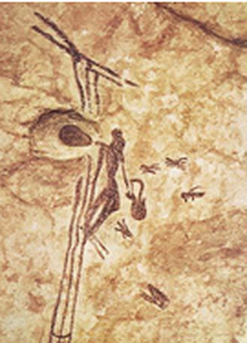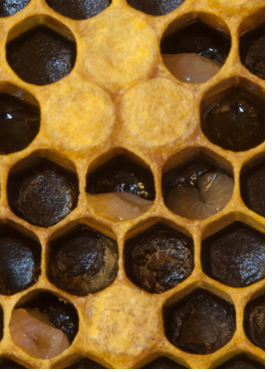|
Symbionts as modulators of honey bee health: lactic acid bacteria and foulbroods. In last week’s colloquia, Dr. Forsgren proposed a possible “missing link” to the problematic widespread honeybee collapse. There are many factors contributing to the decline of honeybee health worldwide and no individual factor stands alone. However, Dr. Forsgren brings us an insight into how our modern agricultural practices may be hindering the internal flora of honeybees. Most bees also form a "superorganism." Much the same way that individual cells combine their simple tasks into a complex organism, bees work individually to perform simple tasks but together form a complex colony that can profoundly impact its surrounding habitat. Honeybees will pollinate large areas of land and as a result have a large impact on our food supply. The honeybee-human mutualistic relationship has been around for a long time. Humans have been cultivating bees since about 8000-2000 BC, a practice that has been important to agricultural, economic, and cultural practices and produces honey, one of the most energy-rich foods that nature produces. Honeybees are responsible for over $220 billion USD in pollination services worldwide. They are considered to be third in food production value for European countries. Those who enjoy tree fruit such as apples, peaches and pears can thank honeybees for their produce. Dr. Forsgren’s research gives us a window into an important community of lactic acid bacteria (LAB), includingLactobacillus and Bifidobacterium, that is critical to bee health. Much like the probiotic bacteria you might find at your local supermarket, Dr. Frosgren shows us that honey bees also benefit from “probiotic bacteria”. Much like what is found within the human gut, these bacteria release beneficial byproducts that improve organism function. However, unlike human gut flora, these probiotic bacteria exist in a diverticulum of the bee's digestive tract called the “honey crop,” where honey and nectar are stored for transport. Byproducts of the bacterial biofilm, such as lactic acid, formic acid, and hydrogen peroxide, provide protection against invasive pathogens. Through examination of LAB, Dr. Forsgren determined a link between bee flora symbionts and reduction of American and European Foulbrood disease propagation. Dr. Forsgren explains that within the honey crop beneficial lactic acid bacteria exist in bee species worldwide. Unique to LAB is their immense diversity: recent discovery in bees alone have doubled in number of species identified globally from 50 to approximately 100. This close association and significant diversity suggest that the role these bacteria play in the colony have been vastly underestimated. Their presence and diversity suggest a symbiotic adaptive feature common among all bees and possibly integral to the preservation of individual and colony health. Dr. Forsgren points out that disease organisms that are transmitted from parent to offspring should have low virulence so as to maintain continuous transmission from queen to daughter. However, when disease transmission occurs rapidly from hive to hive, the selection pressure against virulence would be relaxed. She argues that many practices used in apiculture actually promote transmission between hives and thereby promote virulence in pathogens. Bees are particularly susceptible to diseases such as American and European foulbroods (differentiated by location of their discovery, not impact). Foulbroods are bacterial diseases that cause liquefaction or secondary infection of the larvae. The American Foulbrood disease, caused by Paenibacillus larvae, are very resilient and have existed in the environment for hundreds of years. Multiple genotypes of the bacteria exist, some that kill the larvae before the cell is capped, and others that kill the larvae after the cell is capped. Because the post-capped larvae show no signs of disease, they are often overlooked by worker bees during their maintenance and hygienic practices. Bacterial infection begins in the gut of the bee larvae, eventually penetrating the hemocoel and continuing to degrade the larval body within the comb cell. The remains of the infected larvae are characterized by a brown glue-like substance https://www.youtube.com/watch?v=v2Aa56jut7Y. Antibiotics are used in the US; however, the only legal control option available in Europe is a complete burn-down of the infected colony. The European Foulbrood disease, caused by Melistococcus plutonius has made a considerable comeback in the past decade with a 10-fold increase in diversity discovered thus far. These bacteria are unable to penetrate the hemocoel and larvae die of infection rather than complete deterioration. Typically not as fatal as the American Foulbreed disease, since this diversification, certain strains have conferred 100% fatality, suggesting a possible increase of virulence due to current agricultural and beekeeping management practices. In laboratory research the lactic acid bacteria (LAB) found in honey bees outcompete foulbrood strains on petri dishes. In some cases it actively inhibits the growth of foulbrood by slowing its growth. In bee larvae infected with foulbrood bacteria and treated with LAB, their ability to fight off the foulbrood infection increased. Research by Dr. Forsgren and her colleagues suggests that the increased use of antibiotics in beekeeping to fight off foul brood along with cultural practices such as feeding bees sugar water to reserve honey for human consumption may be harming the probiotic bacteria found in the honeybee digestive tract. These and many other factors may be causing the overall decline in honeybee health in recent years. The knowledge that we can “rescue” some aspect of honeybee health by feeding them lactic acid bacteria provides promising avenues for future treatment and management efforts for honeybee colonies. The discussion on the cost/benefit of antibiotic use in honeybee colonies may gain greater traction as more information emerges on the diverse microcosms found in the honeybee gut that make up their bodies defensive abilities. For for more information on the specific research described here:
Novel lactic acid bacteria inhibiting Paenibacillus larvae in honey bee larvae Symbionts as Major Modulators of Insect Health: Lactic Acid Bacteria and Honeybees Sources: Flickr Creative Commons Images Wikimedia- Creative Commons images Dams, L & M. 1977. Spanish rock art depicting honey gathering during the Mesolithic. Nature. 268:228 - 230. PloS One- Bacterial SEM from : Symbionts as Major Modulators of Insect Health: Lactic Acid Bacteria and Honeybees Armando Rosario-Lebron studies the interactions of cultural practices on agricultural land have on natural enemy populations and focuses on outreach education on arthropods. Lauren Hunt is conducting research focused on biological control of stink bugs, with emphasis on the usage of insectary plants to increase mortality of the invasive brown marmorated stink bug (BMSB). http://cerrutirrhookslab.umd.edu/people/index.html Comments are closed.
|
Categories
All
Archives
June 2024
|
Department of Entomology
University of Maryland
4112 Plant Sciences Building
College Park, MD 20742-4454
USA
Telephone: 301.405.3911
Fax: 301.314.9290
University of Maryland
4112 Plant Sciences Building
College Park, MD 20742-4454
USA
Telephone: 301.405.3911
Fax: 301.314.9290






 RSS Feed
RSS Feed




